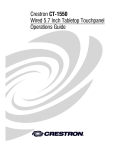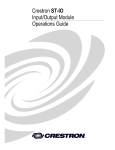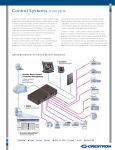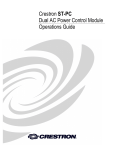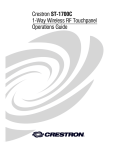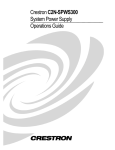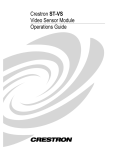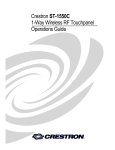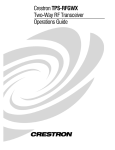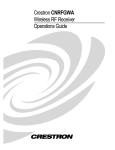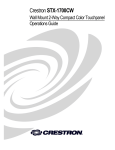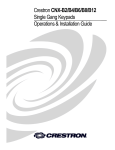Download Crestron CNMK Specifications
Transcript
Crestron CNMK Mouse/Keyboard Controller Operations Guide This document was prepared and written by the Technical Documentation department at: Crestron Electronics, Inc. 15 Volvo Drive Rockleigh, NJ 07647 1-888-CRESTRON All brand names, product names and trademarks are the property of their respective owners. ©2005 Crestron Electronics, Inc. Crestron CNMK Mouse/Keyboard Controller Contents Mouse/Keyboard Controller: CNMK 1 Introduction ............................................................................................................................... 1 Features and Functions ................................................................................................ 1 Specifications .............................................................................................................. 2 Physical Description.................................................................................................... 2 Industry Compliance ................................................................................................... 5 Setup .......................................................................................................................................... 6 Network Wiring........................................................................................................... 6 Identity Code ............................................................................................................... 7 Hardware Hookup ....................................................................................................... 8 Power Up Sequence..................................................................................................... 9 Programming Software .............................................................................................................. 9 Earliest Version Software Requirements for the PC ................................................... 9 Programming with SIMPL Windows .......................................................................... 9 Uploading and Upgrading........................................................................................................ 12 Communication Settings ........................................................................................... 13 Uploading a SIMPL Windows Program.................................................................... 15 Firmware Upgrade..................................................................................................... 16 Problem Solving ...................................................................................................................... 18 Troubleshooting......................................................................................................... 18 Further Inquiries ........................................................................................................ 18 Future Updates .......................................................................................................... 18 Appendix: AT Scan Codes ...................................................................................................... 19 Return and Warranty Policies .................................................................................................. 21 Merchandise Returns / Repair Service ...................................................................... 21 CRESTRON Limited Warranty................................................................................. 21 Operations Guide – DOC. 5699A Contents • i Crestron CNMK Mouse/Keyboard Controller Mouse/Keyboard Controller: CNMK Introduction Features and Functions The Crestron® Mouse/Keyboard Controller, CNMK, with the supplied Y-mouse Adapter, is an expansion module that provides a USB interface between the Crestron network control system (Cresnet®) and a Windows®-based PC. The CNMK allows mouse and keyboard commands to be executed from the control system and sent to the computer to control software applications. The CNMK is also available in an international version, the CNMKI. All features are identical with the exception of the international AC power requirements. The PW-1205 power supply (120 VAC) is provided with the CNMK; the PW-1210 power supply (220 VAC) is provided with the CNMKI. Both units may be powered via Cresnet (with no power supply connected). Throughout this guide, all references to CNMK apply to both versions except where noted. Functional Summary Operations Guide – DOC. 5699A • Provides a USB interface between the Cresnet system and a Windows® based PC • Mouse and keyboard commands executed from the control system are sent to the PC to control software applications • Enables display of QWERTY keyboard equivalent on any large Crestron touchpanel • Can be rack mounted using the optional ST-RMK rack mount kit • Can be powered via Cresnet or provided power supply • Two NET ports allow unit to be daisy-chained with other Cresnet units Mouse/Keyboard Controller: CNMK • 1 Mouse/Keyboard Controller Crestron CNMK Using the CNMK, it is possible to display the equivalent of a QWERTY keyboard on any large Crestron touchpanel to allow manual real-time text entry directly to a PC from the touchpanel screen. Select keyboard commands can be assigned to buttons on any Crestron handheld remote to control computer-based slide presentations. Macros can be easily programmed to execute a string of commands. The CNMK includes pass-through connectors to enable the simultaneous connection of a standard or wireless PS/2 keyboard and mouse. However, since not all PS/2-type keyboards and mice are fully plug-and-play compatible with all PCs, Crestron recommends the use of the supplied Y-mouse Adapter. (Refer to the “Simplified Configuration Diagram” on page 8.) Specifications The table below provides a summary of specifications for the CNMK. Specifications of the CNMK SPECIFICATION DETAILS Cresnet Power Usage 3 Watts (0.125 Amps @ 24 VDC) Default Net ID 28 Control System Update Files 1, 2, 3 2-Series Control System Version 2.004.CUZ or later CNMSX-AV/PRO Version 5.14.02X.UPZ or later CNRACKX/-DP Version 5.14.02W.UPZ or later CEN/CN-TVAV Version 5.12.63V.UPZ or later ST-CP Version 4.02.4S.UPZ or later CNMK Firmware CNMKv2.0.upg or later Environmental Temperature 32° to 113°F (0° to 45°C) Humidity 10% to 90% RH (non-condensing) Overall Dimensions Height: Width: Depth: 1.70 in (4.32 cm) 7.07 in (17.95 cm) 6.33 in (16.06 cm) Weight 2.0 lb (0.90 kg) The latest versions can be obtained from the Crestron website. Refer to NOTE after last footnote. Crestron 2-Series control systems include the AV2 and PRO2. Consult the latest Crestron Product Catalog for a complete list of 2-Series control systems. 3. Filenames for CNX and ST-CP update files have a UPZ extension. Files on the website may be .zip or self-extracting .exe files containing the .cuz or .upz file. All can be obtained from the Downloads section of the Crestron website. To avoid program problems, make sure you are using the update file with the correct suffix letter (e.g., S, V, W, X). 1. 2. NOTE: Crestron software and any files on the website are for Authorized Crestron dealers and Crestron Authorized Independent Programmers (CAIP) only. New users may be required to register to obtain access to certain areas of the site (including the FTP site). Physical Description The CNMK is housed in a black enclosure with labeling on the front and rear panels. Four LEDs on the front of the unit indicate the unit’s status. All the connections are made on the back of the unit. Refer to the following physical views shown after this paragraph. There are four rubber feet on the base of the unit for stability and to prevent slippage. 2 • Mouse/Keyboard Controller: CNMK Operations Guide - DOC. 5699A Crestron CNMK Mouse/Keyboard Controller CNMK Physical Views CNMK Overall Dimensions Operations Guide – DOC. 5699A Mouse/Keyboard Controller: CNMK • 3 Mouse/Keyboard Controller Crestron CNMK CNMK Ports All connections to the CNMK are made through the ports on the back of the unit. Refer to the illustration and descriptions, which follow. CNMK Ports 12 VDC .5 A This DC power socket connector is used to supply external power via the supplied 500 mA power pack (1000 mA power pack for CNMKI configuration). If power for the CNMK is supplied by the Cresnet system, the supplied power pack should be disconnected. NET These two 6-pin, 6-position RJ-11 modular jacks are used to connect the CNMK module to the Cresnet system. Typically, power is provided via the NET connection; the supplied power pack need not be attached. Two NET ports are available so that network units can be daisy-chained together. Review the latest revision of the Network Modular Cable Requirements (Doc. 5682) which is available from the Crestron website (http://www.crestron.com/manuals). NOTE: Most 4-conductor phone cables are wired in a crisscross fashion and are not compatible with Crestron equipment. If the power pack is attached when the CNMK is part of the Cresnet system, power is drawn from the power pack. The CNMK does not load the network power, but the network power remains chained for additional network devices that are connected. TO MOUSE PORT This PS/2 connector connects to one of the PS/2 ports on the supplied Y-mouse Adapter via the supplied cable. MOUSE This PS/2 connector is not typically used. Crestron recommends using the configuration shown in “Hardware Hookup” on page 8. TO KEYBOARD PORT This PS/2 connector connects to one of the PS/2 ports on the supplied Y-mouse Adapter via the supplied cable. KEYBOARD This PS/2 connector is not typically used. Crestron recommends using the configuration shown in “Hardware Hookup” on page 8. 4 • Mouse/Keyboard Controller: CNMK Operations Guide - DOC. 5699A Crestron CNMK Mouse/Keyboard Controller CNMK Indicators There are four LED indicators located on the front panel of the CNMK. Refer to the following illustration and descriptions. CNMK Indicators PWR (Power) This LED illuminates when 12 volts (from the power pack) or 24 volts DC (from network) is supplied to the CNMK. NET This LED illuminates when communication between the Cresnet system and the CNMK is established. Illumination indicates that the SIMPL program currently loaded has a network device defined at the same ID as the CNMK. MOUSE This LED illuminates when the CNMK receives inputs that are translated from the Cresnet system as mouse activity (movement or button presses). KEYBOARD This LED illuminates when the CNMK senses bidirectional signal activity as translated from the Cresnet system as keyboard activity. Industry Compliance As of the date of manufacture, this unit has been tested and found to comply with specifications for CE marking and standards per EMC and Radiocommunications Compliance Labelling. NOTE: This device complies with part 15 of the FCC rules. Operation is subject to the following two conditions: (1) this device may not cause harmful interference, and (2) this device must accept any interference received, including interference that may cause undesired operation. Operations Guide – DOC. 5699A Mouse/Keyboard Controller: CNMK • 5 Mouse/Keyboard Controller Crestron CNMK Setup Network Wiring CAUTION: In order to ensure optimum performance over the full range of your installation topology, Crestron Certified Wire, and only Crestron Certified Wire, should be used. Failure to do so may incur additional charges if support is required to identify performance deficiencies as a result of using improper wire. CAUTION: Use only Crestron power supplies for Crestron equipment. Failure to do so could cause equipment damage or void the Crestron warranty. CAUTION: Provide sufficient power to the system. Insufficient power can lead to unpredictable results or damage to the equipment. Please use the Crestron Power Calculator to help calculate how much power is needed for the system (http://www.crestron.com/calculators). NOTE: When installing network wiring, refer to the latest revision of the wiring diagram(s) appropriate for your specific system configuration, available from the Crestron website. When calculating the wire gauge for a particular Cresnet run, the length of the run and the Cresnet power usage of each network unit to be connected must be taken into consideration. If Cresnet units are to be daisy-chained on the run, the Cresnet power usage of each unit to be daisy-chained must be added together to determine the Cresnet power usage of the entire chain. If the unit is a home-run from a Crestron system power supply network port, the Cresnet power usage of that unit is the Cresnet power usage of the entire run. The length of the run in feet and the Cresnet power usage of the run should be used in the following resistance equation to calculate the value on the right side of the equation. Resistance Equation The required wire gauge should be chosen such that the resistance value is less than the value calculated in the resistance equation. Refer to the following table. Wire Gauge Values RESISTANCE WIRE GAUGE 4 16 6 18 10 20 15 22 13 Doubled CAT5 8.7 Tripled CAT5 NOTE: All Cresnet wiring must consist of two twisted pairs. One twisted pair is the +24V conductor and the GND conductor, and the other twisted pair is the Y conductor and the Z conductor. 6 • Mouse/Keyboard Controller: CNMK Operations Guide - DOC. 5699A Crestron CNMK Mouse/Keyboard Controller NOTE: When daisy-chaining Cresnet units, strip the ends of the wires carefully to avoid nicking the conductors. Twist together the ends of the wires that share a pin on the network connector, and tin the twisted connection. Apply solder only to the ends of the twisted wires. Avoid tinning too far up the wires or the end becomes brittle. Insert the tinned connection into the Cresnet connector and tighten the retaining screw. Repeat the procedure for the other three conductors. Identity Code Every equipment and user interface within the network requires a unique identity code (Net ID). These codes are two-digit hexadecimal numbers from 03 to FE. The Net ID of each unit must match an ID code specified in the SIMPL Windows program. Refer to “Setting the Net ID in Device Settings” on page 11 for details of the SIMPL Windows procedure. Refer to the note on page 13 for a definition of Viewport. The Net ID of the CNMK has been factory set to 28. The Net IDs of multiple CNMKs in the same system must be unique. Net IDs are changed from a personal computer (PC) via the Crestron Viewport. NOTE: For detailed information on establishing communication between the PC and control system, refer to “Communication Settings” on page 13. If communication cannot be established, refer to the “Troubleshooting Communications” section in the latest version of the 2-Series Control System Reference Guide (Doc. 6256) or the respective Operations Guide for the other control systems, which are available from the Crestron website. Set the CNMK Net IDs as follows: 1. Ensure that the CNMK is the only device connected to the control system. 2. Open the Crestron Viewport. 3. From the Viewport menu, select Functions | Set Network ID. The software checks the baud rate and then opens the "Set Network ID" window. 4. In the "Set Network ID" window, select the CNMK from the Current Network Devices text window. 5. Select the new Net ID for the CNMK from the Choose the new network ID for the selected device (Hex): text box. 6. Click Set ID to initiate the change. This will display the "ID command has been sent" window. 7. In the "Command Complete" window, click OK. 8. In the Current Network Devices text window, verify the new Net ID code. 9. In the "Set Network ID" window, click Close. NOTE: The new Net ID code may also be verified by selecting Diagnostic | Report Network Devices in the Viewport (alternately, select F4). 10. Repeat this procedure for each CNMK to be added to the system. Operations Guide – DOC. 5699A Mouse/Keyboard Controller: CNMK • 7 Mouse/Keyboard Controller Crestron CNMK Hardware Hookup Refer to the following hookup diagram. Complete the connections in any order. Refer to “Network Wiring” on page 6. Refer also to “Power Up Sequence” on page 9. Cresnet System Hookup Connections for CNMK NOTE: Verify that you have sufficient Cresnet power to support your net devices. The following diagram shows a portion of a Cresnet configuration that includes the CNMK. The supplied Y-mouse Adapter and cables enable transmission of mouse and keyboard commands from the control system to the PC. A more complete diagram could include a wireless mouse such as the CNWM and its gateway, the CNRFGWA, as well as a touchpanel as sources for the mouse and keyboard commands. Simplified Configuration Diagram 8 • Mouse/Keyboard Controller: CNMK Operations Guide - DOC. 5699A Crestron CNMK Mouse/Keyboard Controller Power Up Sequence The following procedures apply only in instances where the Cresnet configuration includes a keyboard or mouse directly connected to the CNMK. 1. Regardless of the configuration, make all connections before applying power. 2. Apply power to the CNMK and control system. 3. Apply power to the PC. The CNMK initializes with the PC during the power up sequence. To ensure proper initialization and operation, avoid doing any of the following: • Mouse movement during the power up sequence • Pressing any mouse buttons during the power up sequencer To prevent damage to the CNMK mouse and keyboard ports, do not plug or unplug any of the mouse and keyboard connectors to the CNMK while power is applied. Programming Software Have a question or comment about Crestron software? Answers to frequently asked questions (FAQs) can be viewed in the Online Help section of the Crestron website. To post a question or view questions you have submitted to Crestron’s True Blue Support, log in at http://support.crestron.com./ First-time users will need to establish a user account. Earliest Version Software Requirements for the PC NOTE: Crestron recommends that you use the latest software to take advantage of the most recently released features. The latest software is available from the Crestron website. The following are recommended software version requirements for the PC: • SIMPL Windows version 2.03 or later. • Crestron Database version 15.0.0 or later. Required by SIMPL Windows. Programming with SIMPL Windows NOTE: The following are acceptable file extensions for programs that include a CNMK, developed for specific control system types: .smw projectname.smw (source file) .spz projectname.spz (compiled file for 2-Series) .bin projectname.bin (compiled file for CNX generation) .csz projectname.csz (compiled file for CNX generation with SIMPL+) .ush projectname.ush (compiled file for CNX generation with SIMPL+ header file) .usp projectname.usp (source code module for SIMPL+) Operations Guide – DOC. 5699A Mouse/Keyboard Controller: CNMK • 9 Mouse/Keyboard Controller Crestron CNMK SIMPL Windows is Crestron's software for programming Crestron control systems. It provides a well-designed graphical environment with a number of workspaces (i.e., windows) in which a programmer can select, configure, program, test, and monitor a Crestron control system. SIMPL Windows offers drag and drop functionality in a familiar Windows® environment. NOTE: The following assumes that the reader has knowledge of SIMPL Windows. If not, refer to the extensive help information provided with the software. NOTE: In the following description, the PRO2 control system is used. This section describes a sample SIMPL Windows program that includes a CNMK. Configuration Manager is where programmers “build” a Crestron control system by selecting hardware from the Device Library. In Configuration Manager, drag the PRO2 from the Control Systems folder of the Device Library and drop it in the upper pane of the System Views. The PRO2 with its associated communication ports is displayed in the System Views upper pane. PRO2 System View The System Views lower pane displays the PRO2 system tree (refer to following graphic). This tree can be expanded to display and configure the communications ports. Expanded PRO2 System Tree C2Net-Device Slot in Configuration Manager To incorporate a CNMK into the system, drag the CNMK from the Cresnet Control Modules | Cresnet I/O Control& Other Modules folder of the Device Library and drop it in System Views. The PRO2 system tree displays the CNMK in Slot 9, with a default Net ID of 28 as shown in the following illustration. NOTE: The first CNMK in a system is preset with a net ID of 28 when its symbol is dragged into the upper pane of System Views. Additional units are assigned different numbers as they are added. 10 • Mouse/Keyboard Controller: CNMK Operations Guide - DOC. 5699A Crestron CNMK Mouse/Keyboard Controller C2Net Device, Slot 9 Setting the Net ID in Device Settings Double-click the CNMK icon in the upper pane to open the “Device Settings” window. This window displays CNMK device information. Select the Net ID tab to change the Net ID, as shown in the following figure. “Device Settings” Window NOTE: SIMPL Windows automatically changes the Net ID value of a device added to a program if a duplicate device or a device with the same default Net ID already exists in the program. Always ensure that the hardware and software settings of the Net ID match. For Net ID hardware setting details, refer to “Identity Code” on page 7. CNMK Symbol in Programming Manager Programming Manager is where programmers “program” a Crestron control system by assigning signals to symbols. The following illustration shows the CNMK symbol in the SIMPL Windows’ Programming Manager. Detail View of the CNMK in SIMPL Windows’ Programming Manager Operations Guide – DOC. 5699A Mouse/Keyboard Controller: CNMK • 11 Mouse/Keyboard Controller Crestron CNMK Signals interconnect the various devices and logic symbols that comprise a SIMPL program. Signals can be one of three types: digital, analog, or serial. For any given signal, the signal type is determined by its driving source. That is, if the symbol that drives the signal has an analog output, then, by definition, the signal connected there will be an analog signal. For additional information, refer to Doc. 6120, Crestron SIMPL Windows Symbol Guide. It may be downloaded from the Crestron website. The following table lists functional descriptions for the CNMK inputs. CNMK Input Signal Descriptions SIGNAL TYPE AND NAME DESCRIPTION Serial input: <mouse$> The <mouse$> input sends mouse commands to the PC, and is usually driven by the <data> output of the Crestron CNWM RF remote, or by the <mouse$> output of a Mouse Simulator symbol. The CNWM has buttons for right-clicks and left-clicks, as well as a pressure sensitive thumb pad that controls the position of the cursor. Similarly, the inputs of the Mouse Simulator symbol generate right-click and leftclick commands and also control the position of the cursor. The <keyout$> input sends keyboard commands to the PC. Here the data must be converted into keyboard scan code before being sent to the PC. (Refer to the Appendix.) A keyboard scan code is a code number transmitted to an IBM or compatible computer whenever a key is pressed or released. Each key on the keyboard has a unique scan code. This code is not the same as the ASCII code for the letter, number, or symbol shown on the key; it is a special identifier for the key itself and is always the same for a particular key. When a key is pressed (generating a "Make" scan code) or released (generating a "Break" scan code), the scan code is transmitted to the PC, which translates the scan code into its ASCII equivalent. Because a single key can generate more than one character (lowercase a and uppercase A, for example), the PC also keeps track of the status of keys that change the keyboard state, such as the Shift key or Num Lock key, and takes them into account when translating a scan code. Serial input: <keyout$> Uploading and Upgrading NOTE: Crestron recommends that you use the latest software and that each device contains the latest firmware to take advantage of the most recently released features. Please check the Crestron website (http://www.crestron.com/updates) for the latest versions of software and firmware. New users are required to register to obtain access to this site. 12 • Mouse/Keyboard Controller: CNMK Operations Guide - DOC. 5699A Crestron CNMK Mouse/Keyboard Controller Assuming a PC is properly connected to the entire system, Crestron programming software allows the programmer to upload programs and projects after their development to the system and network devices. However, there are times when the files for the program and projects are compiled and not uploaded. Instead, compiled files may be distributed from programmers to installers, from Crestron to dealers, etc. Even firmware upgrades are available from the Crestron website as new features are developed after product releases. In those instances, one has the option to upload via the programming software or to upload and upgrade via the Crestron Viewport. NOTE: The Crestron Viewport utility performs multiple system tasks, primarily via an RS-232 or TCP/IP connection between the control system and a PC. It is used to observe system processes, upload new operating systems and firmware, change system and network parameters, and communicate with network device consoles and touchpanels, among many other tasks. Viewport can also function as a terminal emulator for generic file transfer. All of these functions are accessed through the commands and options in the Viewport menus. Therefore, for its effectiveness as a support and diagnostic tool, the Crestron Viewport may be preferred over development tools when uploading programs and projects. The following sections define how one would upload a SIMPL Windows program or upgrade the firmware of the CNMK. However, before attempting to upgrade, it is necessary to establish communications. Communication Settings NOTE: For laptops and other PCs without a built-in RS-232 port, Crestron recommends the use of PCMCIA cards, rather than USB-to-serial adapters. If a USB-to-serial adapter must be used, Crestron has tested the following devices with good results: Belkin (large model) F5U103 I/O Gear GUC232A (discontinued) Keyspan USA-19QW (discontinued) Results may vary, depending on the computer being used. Other models, even from the same manufacturer, may not yield the same results. The procedure in this section provides details for RS-232 communication between the PC and the control system. If TCP/IP communication is preferred, consult the latest version of the Crestron e-Control Reference Guide (Doc. 6052) or the respective Operations Guide for the control system. These documents are available from the Crestron website. Refer to the following figure for a typical connection diagram when uploading files. NOTE: Use a standard DB9 male to female “straight-through” cable. Operations Guide – DOC. 5699A Mouse/Keyboard Controller: CNMK • 13 Mouse/Keyboard Controller Crestron CNMK Typical Connection Diagram when Uploading 1. Open the Crestron Viewport. Either launch the stand-alone version of Viewport, or start SIMPL Windows and from the menu bar, select Tools | Viewport. 2. From the Viewport menu, select Setup | Communications settings (alternatively, press Alt+D) to open the “Port Settings” window. Refer to the following figures. Accessing the “Port Settings” Window 3. 14 • Mouse/Keyboard Controller: CNMK Select the RS-232 connection type. Verify the available COM is selected. Verify that the baud rate is set to 115200 (PRO2 default), the parity is None, the data bits is Eight, the stop bits is One, XON/XOFF is not selected, and RTS/CTS is selected. Click the OK button to save the settings and close the window. Operations Guide - DOC. 5699A Crestron CNMK Mouse/Keyboard Controller “Port Settings” Window NOTE: The parameters shown in the illustration above are the port settings for a 2-Series control system. Consult the Operations Guide for the control system being used for exact parameter selection. 4. To verify communication, select Diagnostics | Establish Communications (Find Rack). This should display a window that gives the COM port and baud rate. If communication cannot be established, refer to the “Troubleshooting Communications” section in the latest version of the 2-Series Control System Reference Guide (Doc. 6256) or the respective Operations Guide for the other control systems. Uploading a SIMPL Windows Program A control system source file has the extension .smw. A compiled SIMPL Windows file has the extension .spz for a 2-Series control system, .bin for CNX generation, and .csz for CNX generation with SIMPL+. The SIMPL Windows file can be uploaded to the control system using SIMPL Windows or via the Crestron Viewport. Upload via SIMPL Windows 1. Start SIMPL Windows. 2. Select File | Open to view the “Open” window, navigate to the SIMPL Window file (.smw), and click Open. 3. Select Project | Transfer Program. Upload via Crestron Viewport 1. Operations Guide – DOC. 5699A Verify that the procedure for “Communication Settings” that begins on page 13 has been performed. Mouse/Keyboard Controller: CNMK • 15 Mouse/Keyboard Controller Crestron CNMK 2. As shown after this step, select File Transfer | Send Program (alternatively, press Alt+P) from the Viewport menu. File Transfer | Send Program Command 3. The “Send Program” window appears, as shown after this step. Click Browse, locate the compiled file (.spz for PRO2), and click Open. This will display the program's header information and enable one or both of the What to Send check boxes. If the program does not contain any SIMPL+ modules, only the SIMPL Program check box will be enabled. If it does contain SIMPL+ modules, then the SIMPL+ Program(s) check box will also be enabled. Select one or both check boxes and then click Send Program to begin the transfer. NOTE: Refer to the respective Operations Guide for the control system for details about the other fields shown on the “Send Program” window. “Send Program” Window 4. To verify that the program has been transferred successfully, select Diagnostics | Report Program Information. This should display a window that provides details about the current program loaded into the control system. Firmware Upgrade A firmware upgrade file has the extension .upg To take advantage of all the available features, it is important that the unit contains the latest firmware. Please check the Crestron website for the latest version of firmware. Not every product has a firmware upgrade, but as Crestron improves functions, adds new features, and extends the capabilities of its products, firmware upgrades are posted. To upgrade the CNMK firmware, complete the following steps. 1. 16 • Mouse/Keyboard Controller: CNMK Make sure that “Communication Settings” that begins on page 13 has been performed. Suggested baud rate is 38400. Operations Guide - DOC. 5699A Crestron CNMK Mouse/Keyboard Controller 2. As shown after this step, select File Transfer | Update Network Device Firmware from the Viewport menu. File Transfer | Update Network Device Firmware Command 3. As shown in the following figure, select the Net ID of the CNMK and then click OK. “Select Network ID” Window 4. As shown below, select the firmware (UPG) file and click Open. The transfer will complete automatically. Select UPG File Operations Guide – DOC. 5699A Mouse/Keyboard Controller: CNMK • 17 Mouse/Keyboard Controller Crestron CNMK Problem Solving Troubleshooting The table below provides corrective action for possible trouble situations. If further assistance is required, please contact a Crestron customer service representative. CNMK Troubleshooting TROUBLE POSSIBLE CAUSE(S) CORRECTIVE ACTION The unit does not function. The green PWR LED is not illuminated. The wrong power supply is used. Use a Crestron power supply. The unit is not receiving power, or is receiving insufficient power. Verify that cables plugged into the NET port are secure. Verify that the power supply is correct. The unit does not function. The yellow NET LED is not illuminated. The unit Net ID does not match the one in the program. Verify that the CNMK Net ID matches the Net ID in the software program. There is a loose connection located within the network. Verify that the cable plugged into the NET port is secure. Further Inquiries If you cannot locate specific information or have questions after reviewing this guide, please take advantage of Crestron's award winning customer service team by calling the Crestron corporate headquarters at 1-888-CRESTRON [1-888-273-7876]. For assistance in your local time zone, refer to the Crestron website (http://www.crestron.com/) for a listing of Crestron worldwide offices. You can also log onto the online help section of the Crestron website to ask questions about Crestron products. First-time users will need to establish a user account to fully benefit from all available features. Future Updates As Crestron improves functions, adds new features, and extends the capabilities of the CNMK, additional information and programming examples may be made available as manual updates. These updates are solely electronic and serve as intermediary supplements prior to the release of a complete technical documentation revision. Check the Crestron website periodically for manual update availability and its relevance. Updates are identified as an “Addendum” in the Download column. 18 • Mouse/Keyboard Controller: CNMK Operations Guide - DOC. 5699A Crestron CNMK Mouse/Keyboard Controller Appendix: AT Scan Codes The PC interface is designed so the system software has maximum flexibility in defining certain keyboard operations. This is accomplished by having the keyboard return scan codes rather than ASCII codes. Each key generates a “make” scan code when pressed and a “break” scan code when released. The computer system interprets the scan codes to determine what operation it is to perform. The illustration of the PC keyboard, shown below, in conjunction with the AT scan code table, on the following page, provides the “make” and “break” scan codes. Simply identify the specific key on the keyboard illustration. Notice that each key has a “find #” printed in the lower right corner. Locate the “find #” in the AT scan code table to determine the “make” and “break” scan codes. For example, from the keyboard illustration, notice that the “S” key has a “find #” of “32”. From the AT scan code table, notice that “find #” 32 has a “make” scan code of “\x1B” and a “break” scan code of “\xF0\x1B”. Although typical “break” scan code is simply the “make” code preceded by hex F0, there are exceptions. Therefore, refer to the enclosed table for accurate scan codes. PC Keyboard with Find #s Operations Guide – DOC. 5699A Mouse/Keyboard Controller: CNMK • 19 Mouse/Keyboard Controller FIND DESCRIPTION/ "MAKE" "BREAK" # SYMBOL SCAN CODE SCAN CODE 1 ~ \x0E \xF0\x0E 2 1 \x16 \xF0\x16 3 2 \x1E \xF0\x1E 4 3 \x26 \xF0\x26 5 4 \x25 \xF0\x25 6 5 \x2E \xF0\x2E 7 6 \x36 \xF0\x36 8 7 \x3D \xF0\x3D 9 8 \x3E \xF0\x3E 10 9 \x46 \xF0\x46 11 0 \x45 \xF0\x45 12 \x4E \xF0\x4E 13 = \x55 \xF0\x55 15 Backspace \x66 \xF0\x66 16 Tab \x0D \xF0\x0D 17 Q \x15 \xF0\x15 18 W \x1D \xF0\x1D 19 E \x24 \xF0\x24 20 R \x2D \xF0\x2D 21 T \x2C \xF0\x2C 22 Y \x35 \xF0\x35 23 U \x3C \xF0\x3C 24 I \x43 \xF0\x43 25 O \x44 \xF0\x44 26 P \x4D \xF0\x4D 27 [ \x54 \xF0\x54 28 ] \x5B \xF0\x5B 29 \ \x5D \xF0\x5D 30 Cap Lock \x58 \xF0\x58 31 A \x1C \xF0\x1C 32 S \x1B \xF0\x1B 33 D \x23 \xF0\x23 34 F \x2B \xF0\x2B 35 G \x34 \xF0\x34 36 H \x33 \xF0\x33 37 J \x3B \xF0\x3B 38 K \x42 \xF0\x42 39 L \x4B \xF0\x4B 40 ; \x4C \xF0\x4C 41 ' \x52 \xF0\x52 43 Enter \x5A \xF0\x5A 44 Shift (left-most) \x12 \xF0\x12 46 Z \x1A \xF0\x1A 47 X \x22 \xF0\x22 48 C \x21 \xF0\x21 49 V \x2A \xF0\x2A 50 B \x32 \xF0\x32 51 N \x31 \xF0\x31 52 M \x3A \xF0\x3A 53 , \x41 \xF0\x41 54 . \x49 \xF0\x49 20 • Mouse/Keyboard Controller: CNMK Crestron CNMK FIND DESCRIPTION/ "MAKE" SCAN "BREAK" SCAN CODE # SYMBOL CODE 55 / \x4A \xF0\x4A 57 Shift (right-most) \x59 \xF0\x59 58 Ctrl (left-most) \x14 \xF0\x14 60 Alt (left-most) \x11 \xF0\x11 61 Space Bar \x29 \xF0\x29 62 Alt (right-most) \xE0\x11 \xE0\xF0\x11 64 CTRL (right-most) \xE0\x14 \xE0\xF0\x14 75 Insert \xE0\x70 \xE0\xF0\x70 76 Delete \xE0\x71 \xE0\xF0\x71 79 Left Arrow \xE0\x6B \xE0\xF0\x6B 80 Home \xE0\x6C \xE0\xF0\x6C 81 End \xE0\x69 \xE0\xF0\x69 83 Up Arrow \xE0\x75 \xE0\xF0\x75 84 Down Arrow \xE0\x72 \xE0\xF0\x72 85 Page Up \xE0\x7D \xE0\xF0\x7D 86 Page Down \xE0\x7A \xE0\xF0\x7A 89 Right Arrow \xE0\x74 \xE0\xF0\x74 90 Num Lock \x77 \xF0\x77 91 7 (Keypad) \x6C \xF0\x6C 92 4 (Keypad) \x6B \xF0\x6B 93 1 (Keypad) \x69 \xF0\x69 95 / (Keypad) \xE0\x4A \xE0\xF0\x4A 96 8 (Keypad) \x75 \xF0\x75 97 5 (Keypad) \x73 \xF0\x73 98 2 (Keypad) \x72 \xF0\x72 99 0 (Keypad) \x70 \xF0\x70 100 * (Keypad) \x7C \xF0\x7C 101 9 (Keypad) \x7D \xF0\x7D 102 6 (Keypad) \x74 \xF0\x74 103 3 (Keypad) \x7A \xF0\x7A 104 . (Keypad) \x71 \xF0\x71 105 - (Keypad) \x7B \xF0\x7B 106 + (Keypad) \x79 \xF0\x79 108 Enter (Keypad) \xE0\x5A \xE0\xF0\x5A 110 Esc \x76 \xF0\x76 112 F1 \x05 \xF0\x05 113 F2 \x06 \xF0\x06 114 F3 \x04 \xF0\x04 115 F4 \x0C \xF0\x0C 116 F5 \x03 \xF0\x03 117 F6 \x0B \xF0\x0B 118 F7 \x83 \xF0\x83 119 F8 \x0A \xF0\x0A 120 F9 \x01 \xF0\x01 121 F10 \x09 \xF0\x09 122 F11 \x78 \xF0\x78 123 F12 \x07 \xF0\x07 124 Print Screen \xE0\x12\xE0\x7C E0\xF0\x7C\xE0\xF0\x12 125 Scroll Lock \x7E \xF0\x7E 126 Pause \xE1\x14\x77\xE1 \xF0\x14\xF0\x77 Operations Guide - DOC. 5699A Crestron CNMK Mouse/Keyboard Controller Return and Warranty Policies Merchandise Returns / Repair Service 1. No merchandise may be returned for credit, exchange, or service without prior authorization from CRESTRON. To obtain warranty service for CRESTRON products, contact the factory and request an RMA (Return Merchandise Authorization) number. Enclose a note specifying the nature of the problem, name and phone number of contact person, RMA number, and return address. 2. Products may be returned for credit, exchange, or service with a CRESTRON Return Merchandise Authorization (RMA) number. Authorized returns must be shipped freight prepaid to CRESTRON, 6 Volvo Drive, Rockleigh, N.J., or its authorized subsidiaries, with RMA number clearly marked on the outside of all cartons. Shipments arriving freight collect or without an RMA number shall be subject to refusal. CRESTRON reserves the right in its sole and absolute discretion to charge a 15% restocking fee, plus shipping costs, on any products returned with an RMA. 3. Return freight charges following repair of items under warranty shall be paid by CRESTRON, shipping by standard ground carrier. In the event repairs are found to be non-warranty, return freight costs shall be paid by the purchaser. CRESTRON Limited Warranty CRESTRON ELECTRONICS, Inc. warrants its products to be free from manufacturing defects in materials and workmanship under normal use for a period of three (3) years from the date of purchase from CRESTRON, with the following exceptions: disk drives and any other moving or rotating mechanical parts, pan/tilt heads and power supplies are covered for a period of one (1) year; touchscreen display and overlay components are covered for 90 days; batteries and incandescent lamps are not covered. This warranty extends to products purchased directly from CRESTRON or an authorized CRESTRON dealer. Purchasers should inquire of the dealer regarding the nature and extent of the dealer's warranty, if any. CRESTRON shall not be liable to honor the terms of this warranty if the product has been used in any application other than that for which it was intended, or if it has been subjected to misuse, accidental damage, modification, or improper installation procedures. Furthermore, this warranty does not cover any product that has had the serial number altered, defaced, or removed. This warranty shall be the sole and exclusive remedy to the original purchaser. In no event shall CRESTRON be liable for incidental or consequential damages of any kind (property or economic damages inclusive) arising from the sale or use of this equipment. CRESTRON is not liable for any claim made by a third party or made by the purchaser for a third party. CRESTRON shall, at its option, repair or replace any product found defective, without charge for parts or labor. Repaired or replaced equipment and parts supplied under this warranty shall be covered only by the unexpired portion of the warranty. Except as expressly set forth in this warranty, CRESTRON makes no other warranties, expressed or implied, nor authorizes any other party to offer any warranty, including any implied warranties of merchantability or fitness for a particular purpose. Any implied warranties that may be imposed by law are limited to the terms of this limited warranty. This warranty statement supercedes all previous warranties. Trademark Information All brand names, product names, and trademarks are the sole property of their respective owners. Windows is a registered trademark of Microsoft Corporation. Windows95/98/Me/XP and WindowsNT/2000 are trademarks of Microsoft Corporation. Operations Guide – DOC. 5699A Mouse/Keyboard Controller: CNMK • 21 Mouse/Keyboard Controller Crestron CNMK This page intentionally left blank. 22 • Mouse/Keyboard Controller: CNMK Operations Guide - DOC. 5699A Crestron CNMK Mouse/Keyboard Controller This page intentionally left blank. Operations Guide – DOC. 5699A Keyboard/Mouse Controller: CNMK • 23 Crestron Electronics, Inc. 15 Volvo Drive Rockleigh, NJ 07647 Tel: 888.CRESTRON Fax: 201.767.7576 www.crestron.com Operations Guide - DOC. 5699A (2001975) 05.05 Specifications subject to change without notice.




























